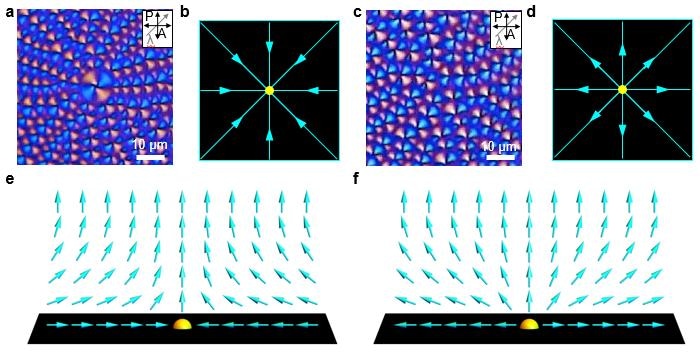Jun 5 2017
For the first time, Scientists at KAIST have noticed the phase transition of the topological defects in liquid crystal (LC) materials.
 Polarizing optical microscopy images of topological defects depending on the strength of the director field. (a,b,e) Convergent director field arrangements of LC molecules and corresponding schematic images; (c,d,f) Divergent director field arrangements of LC molecules and corresponding schematic images. CREDIT: KAIST.
Polarizing optical microscopy images of topological defects depending on the strength of the director field. (a,b,e) Convergent director field arrangements of LC molecules and corresponding schematic images; (c,d,f) Divergent director field arrangements of LC molecules and corresponding schematic images. CREDIT: KAIST.
The phase transition of topological defects, which was also the theme of the Nobel Prize for Physics in 2016, can be difficult to unerstand for a laypersonbut it needs to be studied to understand the mysteries of the universe or the underlying physics of skyrmions, which have intrinsic topological defects.
Taking the galaxy in the universe as an example, it is quite challenging to detect the topological defects as the system is very large to detect specific changes within a restricted time period. Apart from the fact that the defect structures formed by LC molecules have an appropriate size that can be observed through an optical microscope, the time period over which the phase transition of the defect occurs can be directly observed within a few seconds or even to a few minutes. These defect structures have circular, radial or spiral shapes that center on a singularity, that is, a defect core, similar to the singularity presented in the movie, “Interstellar” the center point of a black hole.
Usually, LC materials are predominantly applied in liquid crystal displays (LCDs) and optical sensors as their specific orientation can be easily controlled and they include rapid response features and vast anisotropic optical characteristics. When the defects in the LC materials are reduced, it leads to improved performance of LCDs. The Researchers headed by Professor Dong Ki Yoon from the Graduate School of Nanoscience and Technology not only just reduced the defects; rather, they effectively attempted to use the LC defects as the basis to produce nanostructures and microstructures for patterning applications. While working on their concept, the Researchers discovered a method for direct in situ analysis of the phase transition of topological defects.
While using the LC material in an LCD device, robustness is a highly crucial factor. Hence the capillary phenomenon is used to inject the LC material between a rigid two-glass plate, and thus the orientation of the LCs follow the glass substrate’s surface anchoring condition. Yet, in this traditional instance, it is not so easy to observe the phase transition of the topological defect in the LCs because of the powerful surface anchoring force generated by the solid substrate.
To overcome this difficulty, the Researchers developed a platform wherein the LC molecules’ movement was not limited. For this, they formed a thin film of the LC material on water, similar to the floating of oil on water. They did it by dripping a droplet of the LC material onto water and dispersed it to form a thin film. The thermal phase transition occurring due to the change in temperature can be observed by analyzing the topological defects formed under this condition. Moreover, the technique enables the morphology of the original defect structure to be traced back by analyzing the sequential changes that occurred as a result of the change in temperature, which will enable the topological defect formation in the cosmos or skyrmions to be analyzed.
The study of LC crystal defects itself has been extensively studied by physicists and mathematicians for about 100 years. However, this is the first time that we have observed the phase transition of LC defects directly.” He further stated that “Korea is leading in the LCD industry, but our basic research on LCs is not at the world’s research level.
Professor Dong Ki Yoon, The Graduate School of Nanoscience and Technology